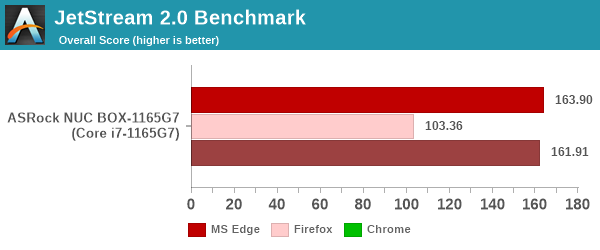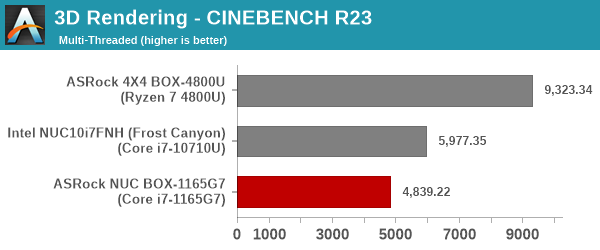ASRock Industrial NUC BOX-1165G7 Mini-PC Review: An Ultra-Compact Tiger Lake Desktop
by Ganesh T S on August 26, 2021 8:15 AM EST- Posted in
- Systems
- Intel
- NUC
- UCFF
- Willow Cove
- ASRock Industrial
- Tiger Lake-U
Miscellaneous Performance Metrics
This section looks at some of the other commonly used benchmarks representative of the performance of specific real-world applications.
Web Browser Benchmarks - JetStream and Speedometer
Web browser-based workloads have emerged as a major component of the typical home and business PC usage scenarios. Beginning with this review, we are including browser-focused benchmarks from the WebKit developers. Hosted at BrowserBench, JetStream 2.0 benchmarks JavaScript and WebAssembly performance, while Speedometer measures web application responsiveness. We also process MotionMark, but the confidence level of the results vary as much as +/-35%. Hence, we present only the Jetstream 2.0 and Speedometer results for the three top browsers below.


In order to maintain reproducibility, we self-host the BrowserBench benchmarks (git clone of the WebKit repository as on July 1, 2021). The browser versions used for the numbers above are presented in the table included in each system's review. Since this is a new benchmark in the suite, the tables for all systems presented in the graphs above are given below.
| ASRock NUC BOX-1165G7 Browser Bench | |||
| Speedometer 2.0 | JetStream 2.0 | MotionMark 1.2 | |
| Microsoft Edge (92.0.902.55) |
140 ± 2.1 | 163.900 | 693.27 ± 16.57% |
| Google Chrome (92.0.4515.107) |
164 ± 3.2 | 161.907 | 813.50 ± 2.29% |
| Mozilla Firefox (90.0.2.7872) |
137 ± 3.0 | 103.359 | 619.00 ± 10.70% |
BAPCo's SYSmark 25 and UL's PCMark benchmarks both include web browser activitites as part of their evaluation scheme. However, the performance for this increasingly important workload tends to get lost in the presentation of a single number. JetStream and Speedometer help us focus on how different PC configurations vary in terms of the user experience with respect to web browsers.
3D Rendering - CINEBENCH R23
We use CINEBENCH R23 for 3D rendering evaluation. R23 provides two benchmark modes - single threaded and multi-threaded. Evaluation of different PC configurations in both supported modes provided us the following results.


Multi-threaded performance suffers when compared against the AMD Renoir offering, and even against Intel's own hexa-core CML-U-based Frost Canyon NUC. However, single-threaded performance is a clear win for the TGL-U mini-PC.
x265 Benchmark
Next up, we have some video encoding benchmarks using x265 v2.8. The appropriate encoder executable is chosen based on the supported CPU features. In the first case, we encode 600 1080p YUV 4:2:0 frames into a 1080p30 HEVC Main-profile compatible video stream at 1 Mbps and record the average number of frames encoded per second.

Our second test case is 1200 4K YUV 4:2:0 frames getting encoded into a 4Kp60 HEVC Main10-profile video stream at 35 Mbps. The encoding FPS is recorded.

This is purely a multi-threaded benchmark, and the 4C/8T TGL-U can't hold a torch to the 6C/12T CML-U or the 8C/16T Renoir APU in the Frost Canyon NUC and the 4X4 BOX-4800U respectively.
7-Zip
7-Zip is a very effective and efficient compression program, often beating out OpenCL accelerated commercial programs in benchmarks even while using just the CPU power. 7-Zip has a benchmarking program that provides tons of details regarding the underlying CPU's efficiency. In this subsection, we are interested in the compression and decompression rates when utilizing all the available threads for the LZMA algorithm.


This is again a test of multi-threading performance, and the TGL-U mini-PC comes in the middle of the pack.
Cryptography Benchmarks
Cryptography has become an indispensable part of our interaction with computing systems. Almost all modern systems have some sort of hardware-acceleration for making cryptographic operations faster and more power efficient. In this sub-section, we look at two different real-world applications that may make use of this acceleration.
BitLocker is a Windows features that encrypts entire disk volumes. While drives that offer encryption capabilities are dealt with using that feature, most legacy systems and external drives have to use the host system implementation. Windows has no direct benchmark for BitLocker. However, we cooked up a BitLocker operation sequence to determine the adeptness of the system at handling BitLocker operations. We start off with a 2.5GB RAM drive in which a 2GB VHD (virtual hard disk) is created. This VHD is then mounted, and BitLocker is enabled on the volume. Once the BitLocker encryption process gets done, BitLocker is disabled. This triggers a decryption process. The times taken to complete the encryption and decryption are recorded. This process is repeated 25 times, and the average of the last 20 iterations is graphed below.


The lack of cores mean that the encryption rate in the TGL-U mini-PC is limited compared to the other systems.
Creation of secure archives is best done through the use of AES-256 as the encryption method while password protecting ZIP files. We re-use the benchmark mode of 7-Zip to determine the AES256-CBC encryption and decryption rates using pure software as well as AES-NI. Note that the 7-Zip benchmark uses a 48KB buffer for this purpose.


Despite slightly higher decryption performance (similar to what we saw for the BitLocker decryption benchmark), the lack of cores mean that the Frost Canyon NUC and the Renoir mini-PC both perform better for dealing with encrypted archives.
Yet another cryptography application is secure network communication. OpenSSL can take advantage of the acceleration provided by the host system to make operations faster. It also has a benchmark mode that can use varying buffer sizes. We recorded the processing rate for a 8KB buffer using the hardware-accelerated AES256-CBC-HAC-SHA1 feature.


Finally, we see one cryptography benchmark where TGL-U comes out as the undoubted leader. This takes away nothing from the fact that the 4C/8T configuration of the Core i7-1165G7 acts as a detriment across many common consumer workloads.
Agisoft Photoscan
Agisoft PhotoScan is a commercial program that converts 2D images into 3D point maps, meshes and textures. The program designers sent us a command line version in order to evaluate the efficiency of various systems that go under our review scanner. The command line version has two benchmark modes, one using the CPU and the other using both the CPU and GPU (via OpenCL). We present the results from our evaluation using the CPU mode only. The benchmark (v1.3) takes 84 photographs and does four stages of computation:
- Stage 1: Align Photographs (capable of OpenCL acceleration)
- Stage 2: Build Point Cloud (capable of OpenCL acceleration)
- Stage 3: Build Mesh
- Stage 4: Build Textures
We record the time taken for each stage. Since various elements of the software are single threaded, and others multithreaded, it is interesting to record the effects of CPU generations, speeds, number of cores, and DRAM parameters using this software.




Better single-threaded performance is no match for the additional cores that Photoscan is able to utilize to shorten the processing time in multiple stages.
Dolphin Emulator
Wrapping up our application benchmark numbers is the new Dolphin Emulator (v5) benchmark mode results.

The single-threaded performance advantage for Tiger Lake enables the NUC BOX-1165G7 to complete the Dolphin emulator benchmark faster than any of the other systems it is being compared against.










33 Comments
View All Comments
TheinsanegamerN - Thursday, August 26, 2021 - link
Really dissapointed there are no games benchmarked." If AMD's OEMs manage to create a mini-PC with, say, the Ryzen 7 5800U in a 25W cTDP-up configuration, Tiger Lake-U's appeal could be dented further."
Well that's just not going to happen. Even now 4700/4800u NUC sized PCs are extremely rare, and AMD isnt going to bother making their own.
xsoft7 - Thursday, August 26, 2021 - link
there is a Zen3 mini PC.. with 5900HXhttps://store.minisforum.com/collections/all-produ...
TheinsanegamerN - Friday, August 27, 2021 - link
Now that's interesting. Not a single tech outlet has talked about these guys yet.ganeshts - Friday, August 27, 2021 - link
Coverage dated Aug. 4th: https://www.anandtech.com/show/16866/minisforum-un...TheinsanegamerN - Tuesday, September 7, 2021 - link
That's nothing more then a product announcement. It's not a review, and if we base a products coverage by announcements then there are 15 electric trucks on the market already.meacupla - Thursday, August 26, 2021 - link
By "rare", do you mean product variety, or product availability?Because I can totally find the 4x4 BOX-4800U in stock, at newegg. They even have a BRIX with 4800U in stock.
Of course, if you are outside of NA, then GL with that.
domih - Thursday, August 26, 2021 - link
4x4 BOX-4800U user here in California. I bought it on NewEgg months ago, then it became out of stock, then apparently NewEgg is expecting a new batch. Good news for you guys: it is even less expensive now. Experience matches this review. Yes, the 4800U model has DASH allowing out-of-band management. The box is so small that some wide USB keys won't coexist pacifically with others. Ubuntu 20.04. When I ran Phoronix tests the box went quite hot and the fan is not really silent. Should be OK as HTPC though, won't get that hot playing video.ifThenError - Friday, August 27, 2021 - link
>> Well that's just not going to happen.Well not quite so fortunately! Gigabyte has anounced a UCFF barebone going up to a Ryzen 7 5800u to be released in "available in Q3 2021".
https://www.gigabyte.com/Press/News/1915
In theory you could order one within the next 1 - 2 months, if and when you can really purchase these, we will see...
quiksilvr - Friday, August 27, 2021 - link
More disappointed that upon looking at the gallery it is two USB-C ports and not a Thunderbolt 4 port on the device.ginandbacon - Sunday, October 10, 2021 - link
I own this device, you have to install a TB driver and I have a TB4 Hub attached with two TB3 NVME drives and they both work at TB3 speeds (40Gbps), Asrock didn't want to pay Intel, I bet Asrock gets sued over this. You can find the board on Ebay for around $260 if you are willing to wait, it's the better deal, the case is junk anyways. I was under the impression that both front USB C ports where TB4 but Asrock hinted they were and only one is.